Control Weaknesses in Sales and Debtors' Procedures: Implications and Improvements
VerifiedAdded on 2022/12/30
|11
|3989
|68
AI Summary
This document discusses the control weaknesses in the sales and debtors' procedures of a company, their implications, and suggests ways for improvement. It highlights issues such as lack of formal procedures, inaccurate recording of transactions, and difficulties in chasing outstanding amounts. The document also provides recommendations to mitigate risks and improve cash flow.
Contribute Materials
Your contribution can guide someone’s learning journey. Share your
documents today.
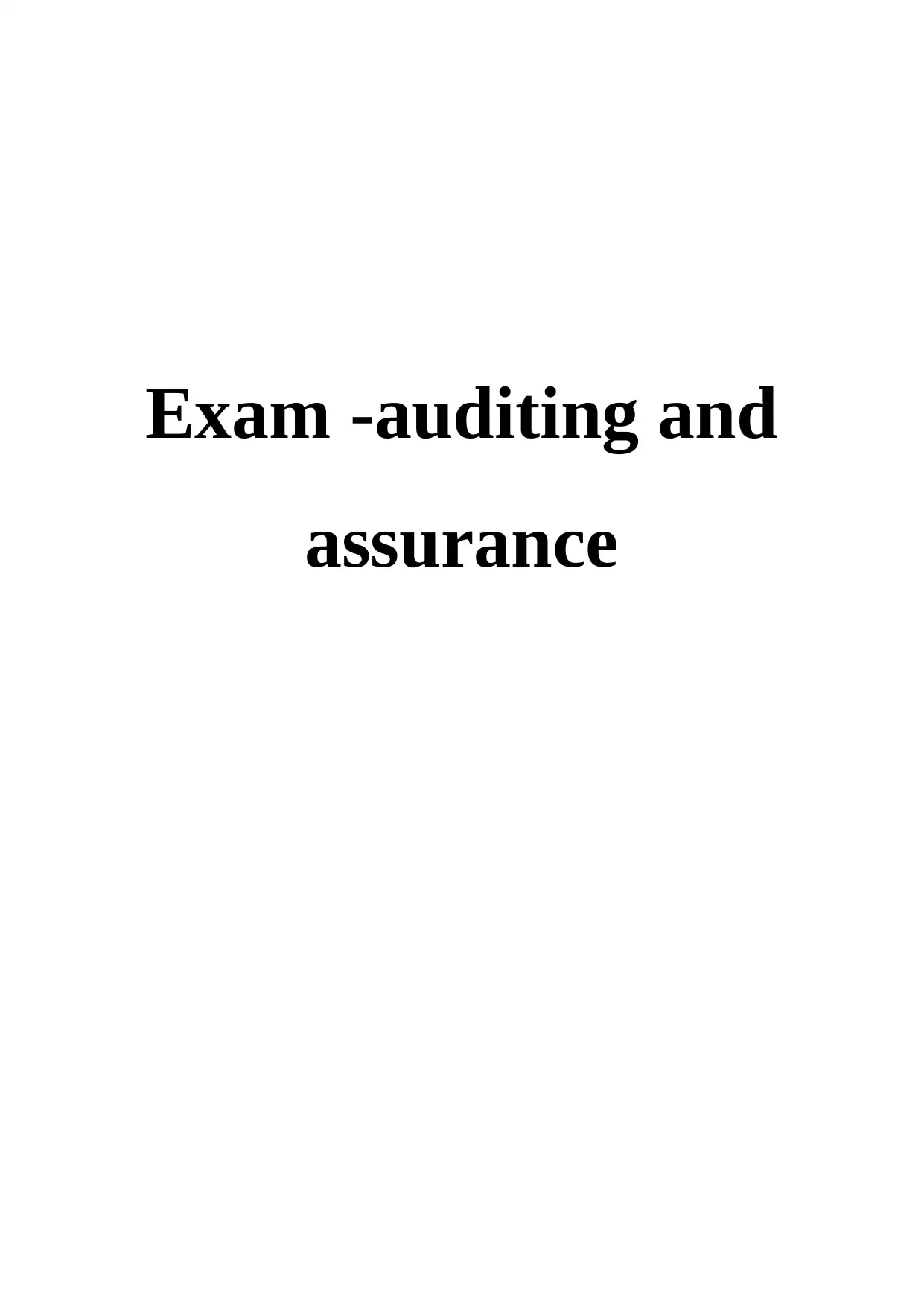
Exam -auditing and
assurance
assurance
Secure Best Marks with AI Grader
Need help grading? Try our AI Grader for instant feedback on your assignments.

TABLE OF CONTENTS
Section A....................................................................................................................................3
Question A1...........................................................................................................................3
Question A2...........................................................................................................................3
Question A3...........................................................................................................................4
Question A4...........................................................................................................................4
Section B....................................................................................................................................5
Question B1............................................................................................................................5
Question B2............................................................................................................................6
Question B3............................................................................................................................6
Question B4............................................................................................................................7
Question B5............................................................................................................................7
Section C....................................................................................................................................8
Question C1............................................................................................................................8
REFERENCES.........................................................................................................................11
Section A....................................................................................................................................3
Question A1...........................................................................................................................3
Question A2...........................................................................................................................3
Question A3...........................................................................................................................4
Question A4...........................................................................................................................4
Section B....................................................................................................................................5
Question B1............................................................................................................................5
Question B2............................................................................................................................6
Question B3............................................................................................................................6
Question B4............................................................................................................................7
Question B5............................................................................................................................7
Section C....................................................................................................................................8
Question C1............................................................................................................................8
REFERENCES.........................................................................................................................11
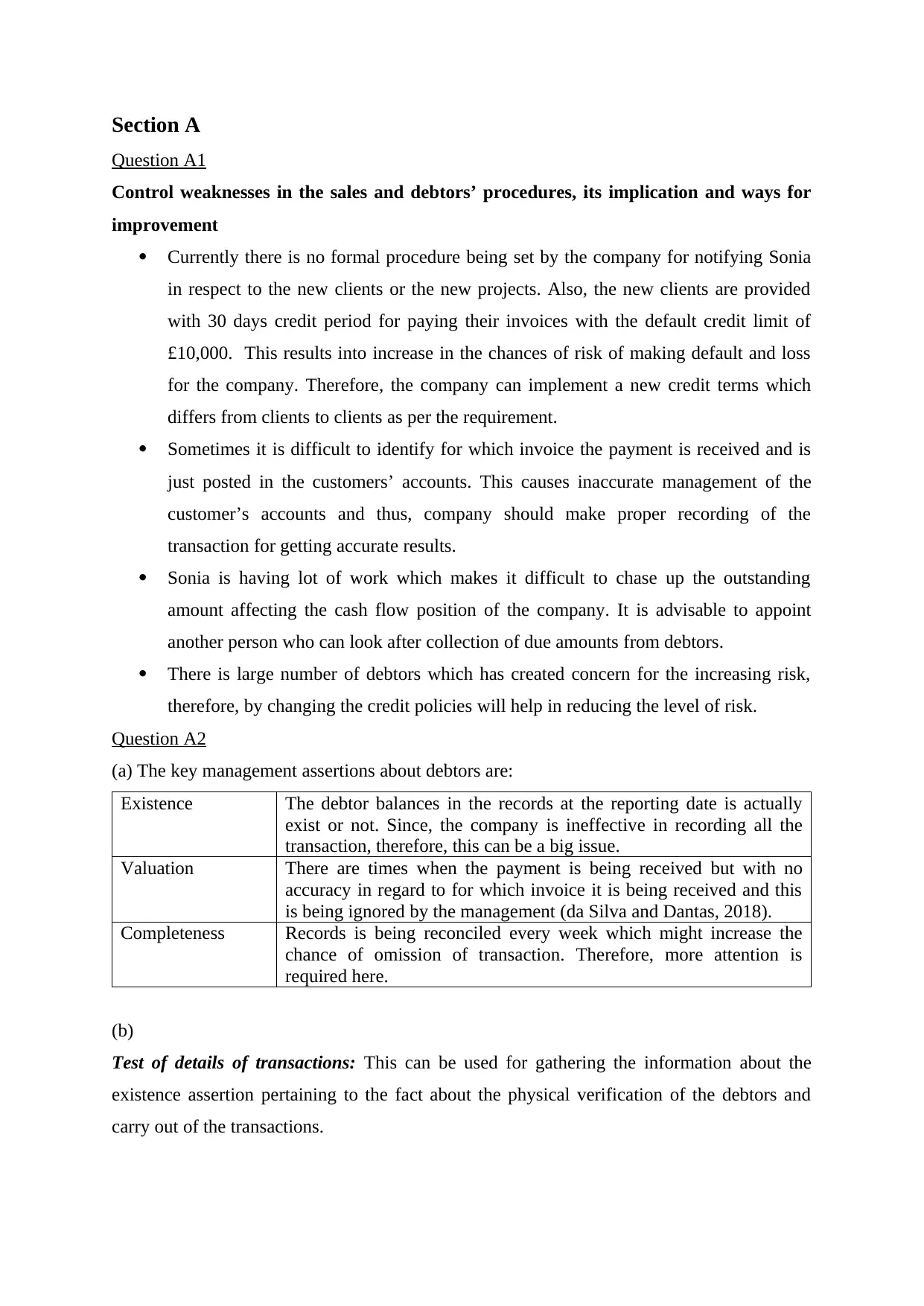
Section A
Question A1
Control weaknesses in the sales and debtors’ procedures, its implication and ways for
improvement
Currently there is no formal procedure being set by the company for notifying Sonia
in respect to the new clients or the new projects. Also, the new clients are provided
with 30 days credit period for paying their invoices with the default credit limit of
£10,000. This results into increase in the chances of risk of making default and loss
for the company. Therefore, the company can implement a new credit terms which
differs from clients to clients as per the requirement.
Sometimes it is difficult to identify for which invoice the payment is received and is
just posted in the customers’ accounts. This causes inaccurate management of the
customer’s accounts and thus, company should make proper recording of the
transaction for getting accurate results.
Sonia is having lot of work which makes it difficult to chase up the outstanding
amount affecting the cash flow position of the company. It is advisable to appoint
another person who can look after collection of due amounts from debtors.
There is large number of debtors which has created concern for the increasing risk,
therefore, by changing the credit policies will help in reducing the level of risk.
Question A2
(a) The key management assertions about debtors are:
Existence The debtor balances in the records at the reporting date is actually
exist or not. Since, the company is ineffective in recording all the
transaction, therefore, this can be a big issue.
Valuation There are times when the payment is being received but with no
accuracy in regard to for which invoice it is being received and this
is being ignored by the management (da Silva and Dantas, 2018).
Completeness Records is being reconciled every week which might increase the
chance of omission of transaction. Therefore, more attention is
required here.
(b)
Test of details of transactions: This can be used for gathering the information about the
existence assertion pertaining to the fact about the physical verification of the debtors and
carry out of the transactions.
Question A1
Control weaknesses in the sales and debtors’ procedures, its implication and ways for
improvement
Currently there is no formal procedure being set by the company for notifying Sonia
in respect to the new clients or the new projects. Also, the new clients are provided
with 30 days credit period for paying their invoices with the default credit limit of
£10,000. This results into increase in the chances of risk of making default and loss
for the company. Therefore, the company can implement a new credit terms which
differs from clients to clients as per the requirement.
Sometimes it is difficult to identify for which invoice the payment is received and is
just posted in the customers’ accounts. This causes inaccurate management of the
customer’s accounts and thus, company should make proper recording of the
transaction for getting accurate results.
Sonia is having lot of work which makes it difficult to chase up the outstanding
amount affecting the cash flow position of the company. It is advisable to appoint
another person who can look after collection of due amounts from debtors.
There is large number of debtors which has created concern for the increasing risk,
therefore, by changing the credit policies will help in reducing the level of risk.
Question A2
(a) The key management assertions about debtors are:
Existence The debtor balances in the records at the reporting date is actually
exist or not. Since, the company is ineffective in recording all the
transaction, therefore, this can be a big issue.
Valuation There are times when the payment is being received but with no
accuracy in regard to for which invoice it is being received and this
is being ignored by the management (da Silva and Dantas, 2018).
Completeness Records is being reconciled every week which might increase the
chance of omission of transaction. Therefore, more attention is
required here.
(b)
Test of details of transactions: This can be used for gathering the information about the
existence assertion pertaining to the fact about the physical verification of the debtors and
carry out of the transactions.
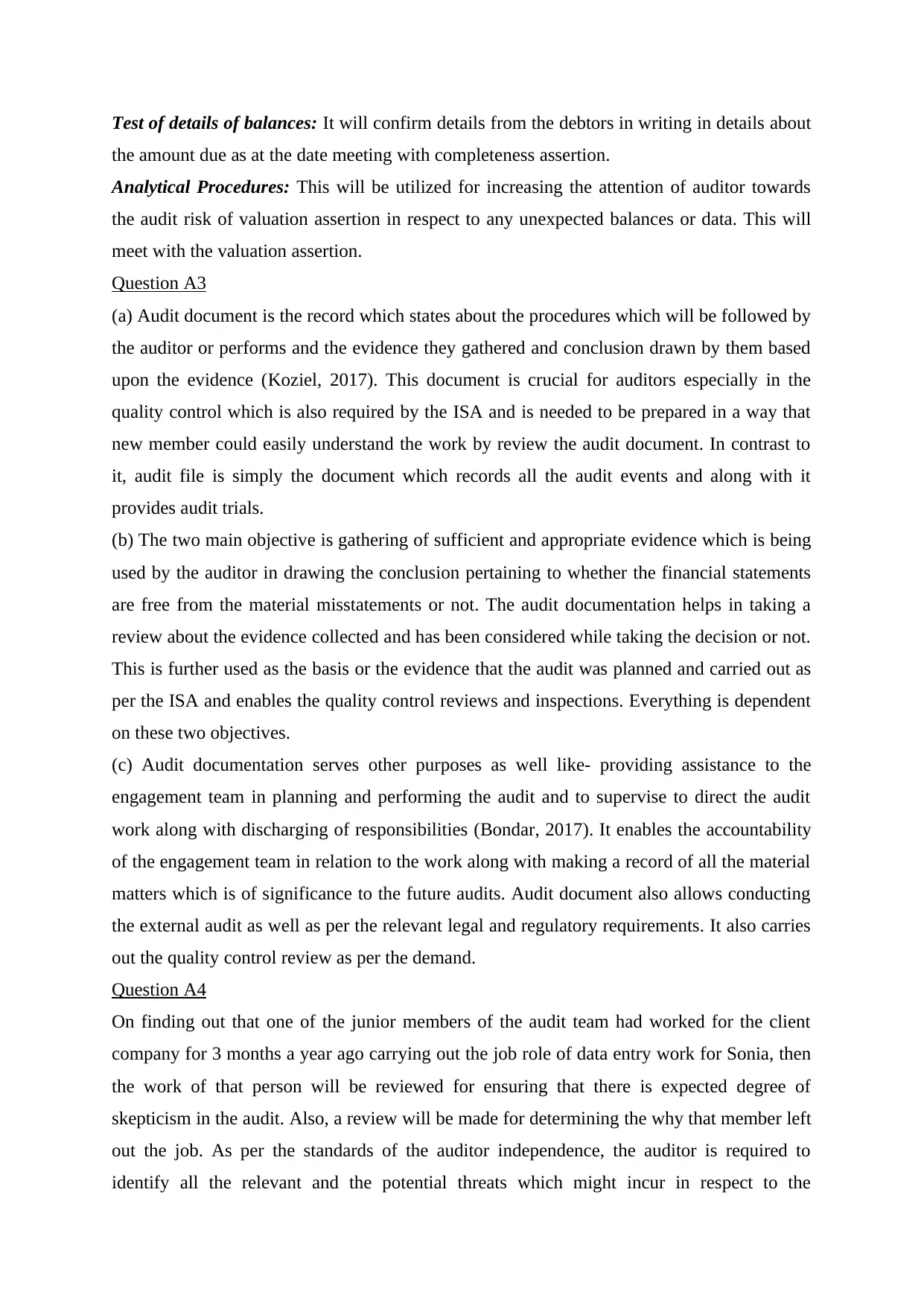
Test of details of balances: It will confirm details from the debtors in writing in details about
the amount due as at the date meeting with completeness assertion.
Analytical Procedures: This will be utilized for increasing the attention of auditor towards
the audit risk of valuation assertion in respect to any unexpected balances or data. This will
meet with the valuation assertion.
Question A3
(a) Audit document is the record which states about the procedures which will be followed by
the auditor or performs and the evidence they gathered and conclusion drawn by them based
upon the evidence (Koziel, 2017). This document is crucial for auditors especially in the
quality control which is also required by the ISA and is needed to be prepared in a way that
new member could easily understand the work by review the audit document. In contrast to
it, audit file is simply the document which records all the audit events and along with it
provides audit trials.
(b) The two main objective is gathering of sufficient and appropriate evidence which is being
used by the auditor in drawing the conclusion pertaining to whether the financial statements
are free from the material misstatements or not. The audit documentation helps in taking a
review about the evidence collected and has been considered while taking the decision or not.
This is further used as the basis or the evidence that the audit was planned and carried out as
per the ISA and enables the quality control reviews and inspections. Everything is dependent
on these two objectives.
(c) Audit documentation serves other purposes as well like- providing assistance to the
engagement team in planning and performing the audit and to supervise to direct the audit
work along with discharging of responsibilities (Bondar, 2017). It enables the accountability
of the engagement team in relation to the work along with making a record of all the material
matters which is of significance to the future audits. Audit document also allows conducting
the external audit as well as per the relevant legal and regulatory requirements. It also carries
out the quality control review as per the demand.
Question A4
On finding out that one of the junior members of the audit team had worked for the client
company for 3 months a year ago carrying out the job role of data entry work for Sonia, then
the work of that person will be reviewed for ensuring that there is expected degree of
skepticism in the audit. Also, a review will be made for determining the why that member left
out the job. As per the standards of the auditor independence, the auditor is required to
identify all the relevant and the potential threats which might incur in respect to the
the amount due as at the date meeting with completeness assertion.
Analytical Procedures: This will be utilized for increasing the attention of auditor towards
the audit risk of valuation assertion in respect to any unexpected balances or data. This will
meet with the valuation assertion.
Question A3
(a) Audit document is the record which states about the procedures which will be followed by
the auditor or performs and the evidence they gathered and conclusion drawn by them based
upon the evidence (Koziel, 2017). This document is crucial for auditors especially in the
quality control which is also required by the ISA and is needed to be prepared in a way that
new member could easily understand the work by review the audit document. In contrast to
it, audit file is simply the document which records all the audit events and along with it
provides audit trials.
(b) The two main objective is gathering of sufficient and appropriate evidence which is being
used by the auditor in drawing the conclusion pertaining to whether the financial statements
are free from the material misstatements or not. The audit documentation helps in taking a
review about the evidence collected and has been considered while taking the decision or not.
This is further used as the basis or the evidence that the audit was planned and carried out as
per the ISA and enables the quality control reviews and inspections. Everything is dependent
on these two objectives.
(c) Audit documentation serves other purposes as well like- providing assistance to the
engagement team in planning and performing the audit and to supervise to direct the audit
work along with discharging of responsibilities (Bondar, 2017). It enables the accountability
of the engagement team in relation to the work along with making a record of all the material
matters which is of significance to the future audits. Audit document also allows conducting
the external audit as well as per the relevant legal and regulatory requirements. It also carries
out the quality control review as per the demand.
Question A4
On finding out that one of the junior members of the audit team had worked for the client
company for 3 months a year ago carrying out the job role of data entry work for Sonia, then
the work of that person will be reviewed for ensuring that there is expected degree of
skepticism in the audit. Also, a review will be made for determining the why that member left
out the job. As per the standards of the auditor independence, the auditor is required to
identify all the relevant and the potential threats which might incur in respect to the
Secure Best Marks with AI Grader
Need help grading? Try our AI Grader for instant feedback on your assignments.
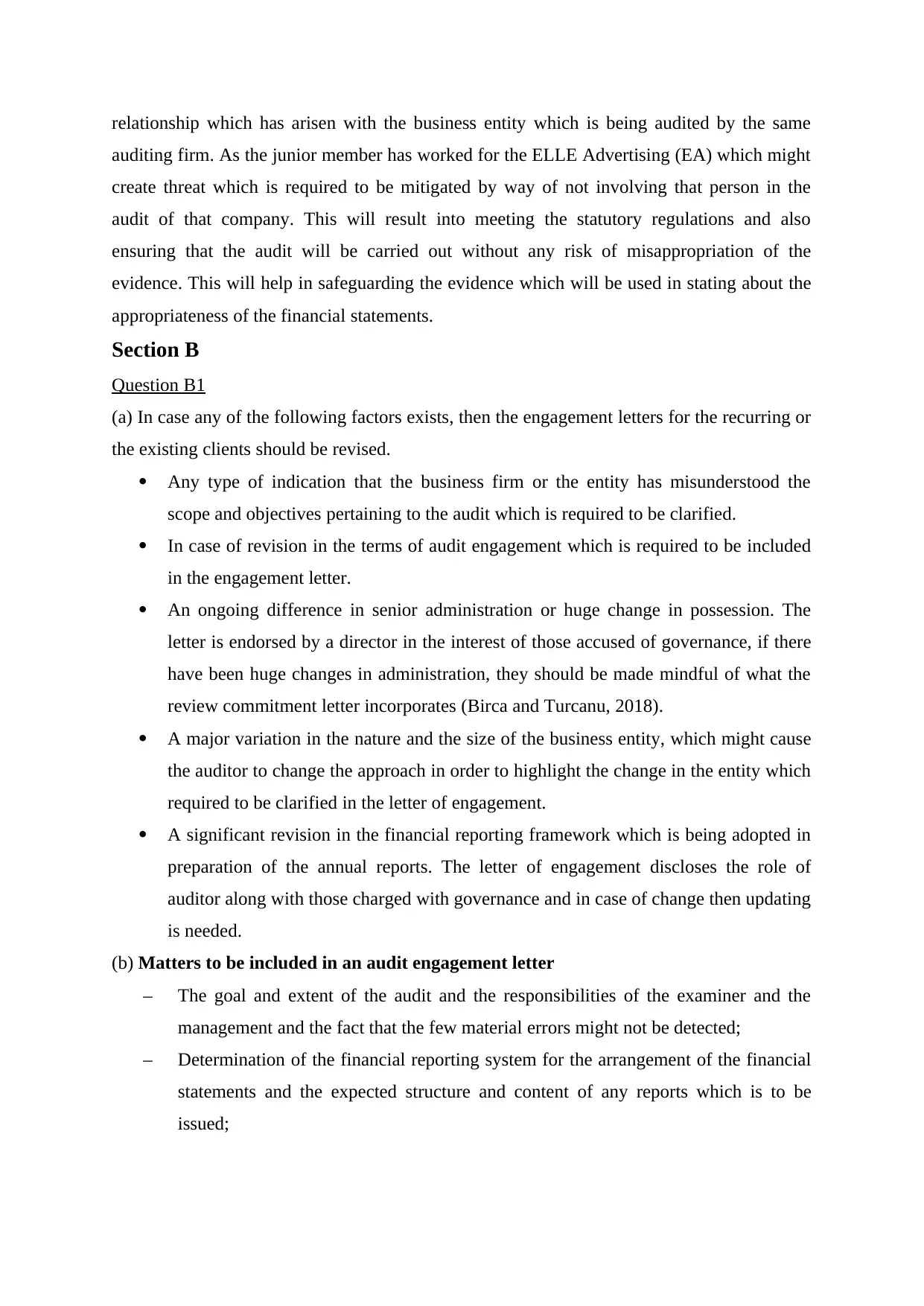
relationship which has arisen with the business entity which is being audited by the same
auditing firm. As the junior member has worked for the ELLE Advertising (EA) which might
create threat which is required to be mitigated by way of not involving that person in the
audit of that company. This will result into meeting the statutory regulations and also
ensuring that the audit will be carried out without any risk of misappropriation of the
evidence. This will help in safeguarding the evidence which will be used in stating about the
appropriateness of the financial statements.
Section B
Question B1
(a) In case any of the following factors exists, then the engagement letters for the recurring or
the existing clients should be revised.
Any type of indication that the business firm or the entity has misunderstood the
scope and objectives pertaining to the audit which is required to be clarified.
In case of revision in the terms of audit engagement which is required to be included
in the engagement letter.
An ongoing difference in senior administration or huge change in possession. The
letter is endorsed by a director in the interest of those accused of governance, if there
have been huge changes in administration, they should be made mindful of what the
review commitment letter incorporates (Birca and Turcanu, 2018).
A major variation in the nature and the size of the business entity, which might cause
the auditor to change the approach in order to highlight the change in the entity which
required to be clarified in the letter of engagement.
A significant revision in the financial reporting framework which is being adopted in
preparation of the annual reports. The letter of engagement discloses the role of
auditor along with those charged with governance and in case of change then updating
is needed.
(b) Matters to be included in an audit engagement letter
– The goal and extent of the audit and the responsibilities of the examiner and the
management and the fact that the few material errors might not be detected;
– Determination of the financial reporting system for the arrangement of the financial
statements and the expected structure and content of any reports which is to be
issued;
auditing firm. As the junior member has worked for the ELLE Advertising (EA) which might
create threat which is required to be mitigated by way of not involving that person in the
audit of that company. This will result into meeting the statutory regulations and also
ensuring that the audit will be carried out without any risk of misappropriation of the
evidence. This will help in safeguarding the evidence which will be used in stating about the
appropriateness of the financial statements.
Section B
Question B1
(a) In case any of the following factors exists, then the engagement letters for the recurring or
the existing clients should be revised.
Any type of indication that the business firm or the entity has misunderstood the
scope and objectives pertaining to the audit which is required to be clarified.
In case of revision in the terms of audit engagement which is required to be included
in the engagement letter.
An ongoing difference in senior administration or huge change in possession. The
letter is endorsed by a director in the interest of those accused of governance, if there
have been huge changes in administration, they should be made mindful of what the
review commitment letter incorporates (Birca and Turcanu, 2018).
A major variation in the nature and the size of the business entity, which might cause
the auditor to change the approach in order to highlight the change in the entity which
required to be clarified in the letter of engagement.
A significant revision in the financial reporting framework which is being adopted in
preparation of the annual reports. The letter of engagement discloses the role of
auditor along with those charged with governance and in case of change then updating
is needed.
(b) Matters to be included in an audit engagement letter
– The goal and extent of the audit and the responsibilities of the examiner and the
management and the fact that the few material errors might not be detected;
– Determination of the financial reporting system for the arrangement of the financial
statements and the expected structure and content of any reports which is to be
issued;
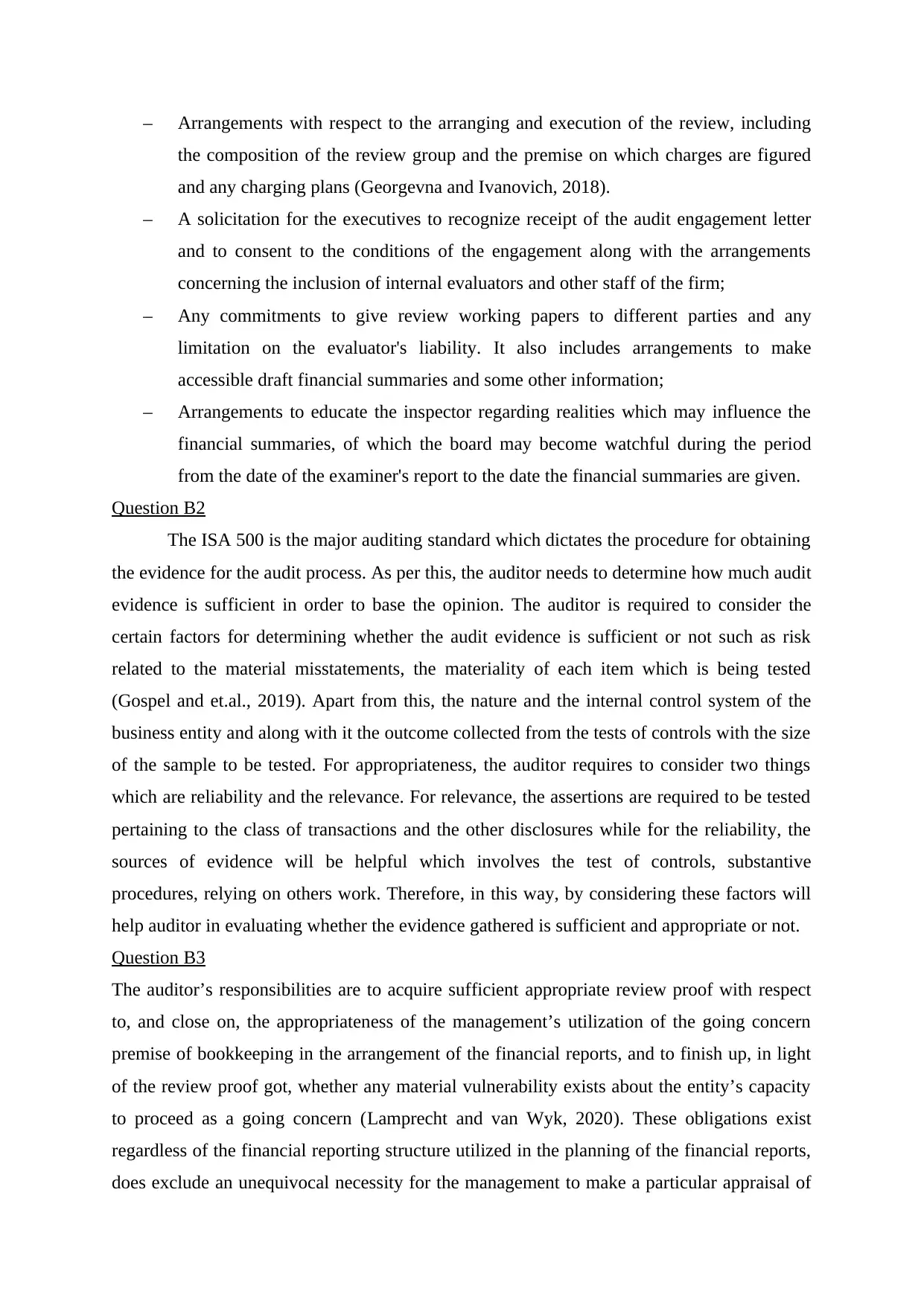
– Arrangements with respect to the arranging and execution of the review, including
the composition of the review group and the premise on which charges are figured
and any charging plans (Georgevna and Ivanovich, 2018).
– A solicitation for the executives to recognize receipt of the audit engagement letter
and to consent to the conditions of the engagement along with the arrangements
concerning the inclusion of internal evaluators and other staff of the firm;
– Any commitments to give review working papers to different parties and any
limitation on the evaluator's liability. It also includes arrangements to make
accessible draft financial summaries and some other information;
– Arrangements to educate the inspector regarding realities which may influence the
financial summaries, of which the board may become watchful during the period
from the date of the examiner's report to the date the financial summaries are given.
Question B2
The ISA 500 is the major auditing standard which dictates the procedure for obtaining
the evidence for the audit process. As per this, the auditor needs to determine how much audit
evidence is sufficient in order to base the opinion. The auditor is required to consider the
certain factors for determining whether the audit evidence is sufficient or not such as risk
related to the material misstatements, the materiality of each item which is being tested
(Gospel and et.al., 2019). Apart from this, the nature and the internal control system of the
business entity and along with it the outcome collected from the tests of controls with the size
of the sample to be tested. For appropriateness, the auditor requires to consider two things
which are reliability and the relevance. For relevance, the assertions are required to be tested
pertaining to the class of transactions and the other disclosures while for the reliability, the
sources of evidence will be helpful which involves the test of controls, substantive
procedures, relying on others work. Therefore, in this way, by considering these factors will
help auditor in evaluating whether the evidence gathered is sufficient and appropriate or not.
Question B3
The auditor’s responsibilities are to acquire sufficient appropriate review proof with respect
to, and close on, the appropriateness of the management’s utilization of the going concern
premise of bookkeeping in the arrangement of the financial reports, and to finish up, in light
of the review proof got, whether any material vulnerability exists about the entity’s capacity
to proceed as a going concern (Lamprecht and van Wyk, 2020). These obligations exist
regardless of the financial reporting structure utilized in the planning of the financial reports,
does exclude an unequivocal necessity for the management to make a particular appraisal of
the composition of the review group and the premise on which charges are figured
and any charging plans (Georgevna and Ivanovich, 2018).
– A solicitation for the executives to recognize receipt of the audit engagement letter
and to consent to the conditions of the engagement along with the arrangements
concerning the inclusion of internal evaluators and other staff of the firm;
– Any commitments to give review working papers to different parties and any
limitation on the evaluator's liability. It also includes arrangements to make
accessible draft financial summaries and some other information;
– Arrangements to educate the inspector regarding realities which may influence the
financial summaries, of which the board may become watchful during the period
from the date of the examiner's report to the date the financial summaries are given.
Question B2
The ISA 500 is the major auditing standard which dictates the procedure for obtaining
the evidence for the audit process. As per this, the auditor needs to determine how much audit
evidence is sufficient in order to base the opinion. The auditor is required to consider the
certain factors for determining whether the audit evidence is sufficient or not such as risk
related to the material misstatements, the materiality of each item which is being tested
(Gospel and et.al., 2019). Apart from this, the nature and the internal control system of the
business entity and along with it the outcome collected from the tests of controls with the size
of the sample to be tested. For appropriateness, the auditor requires to consider two things
which are reliability and the relevance. For relevance, the assertions are required to be tested
pertaining to the class of transactions and the other disclosures while for the reliability, the
sources of evidence will be helpful which involves the test of controls, substantive
procedures, relying on others work. Therefore, in this way, by considering these factors will
help auditor in evaluating whether the evidence gathered is sufficient and appropriate or not.
Question B3
The auditor’s responsibilities are to acquire sufficient appropriate review proof with respect
to, and close on, the appropriateness of the management’s utilization of the going concern
premise of bookkeeping in the arrangement of the financial reports, and to finish up, in light
of the review proof got, whether any material vulnerability exists about the entity’s capacity
to proceed as a going concern (Lamprecht and van Wyk, 2020). These obligations exist
regardless of the financial reporting structure utilized in the planning of the financial reports,
does exclude an unequivocal necessity for the management to make a particular appraisal of
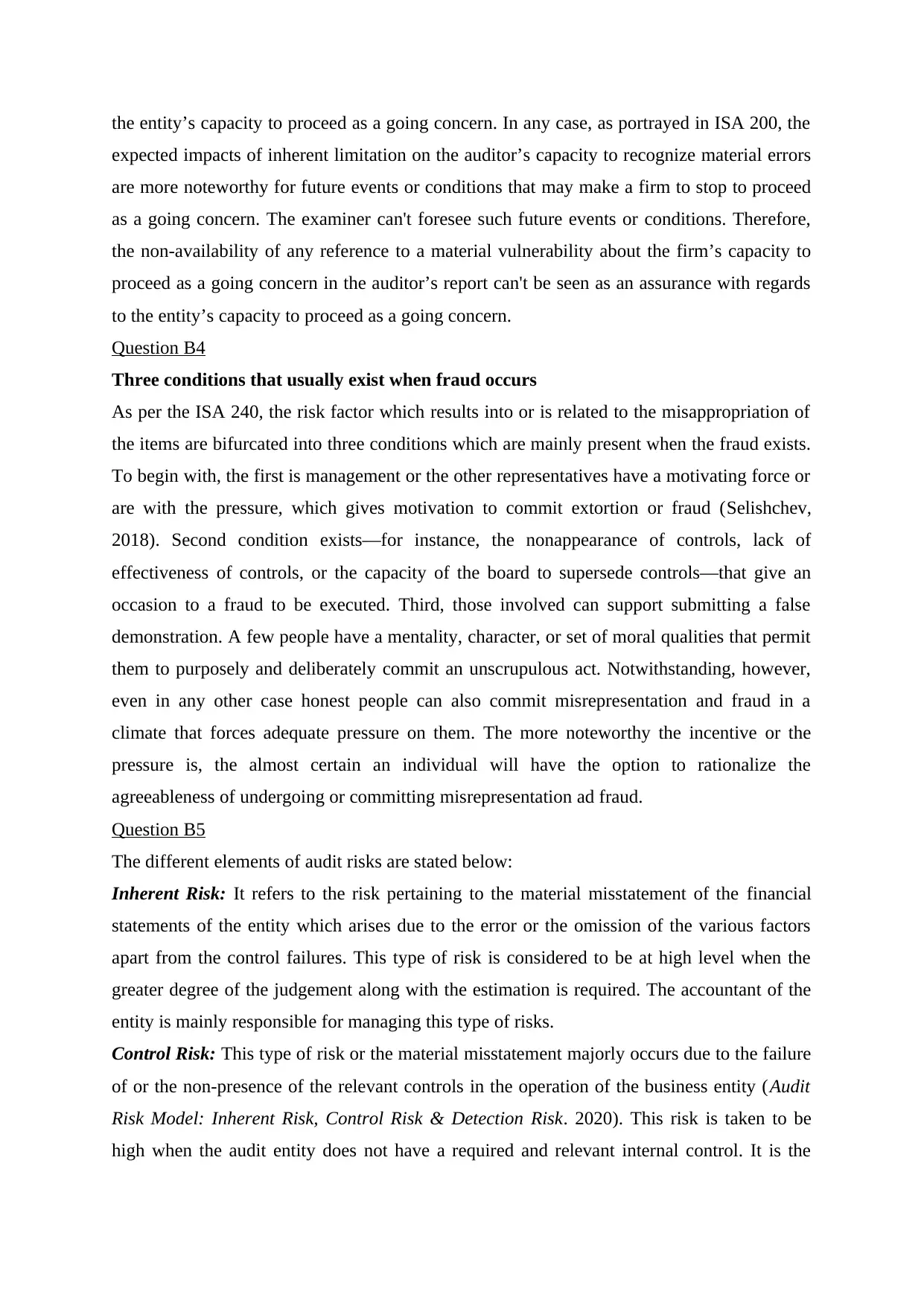
the entity’s capacity to proceed as a going concern. In any case, as portrayed in ISA 200, the
expected impacts of inherent limitation on the auditor’s capacity to recognize material errors
are more noteworthy for future events or conditions that may make a firm to stop to proceed
as a going concern. The examiner can't foresee such future events or conditions. Therefore,
the non-availability of any reference to a material vulnerability about the firm’s capacity to
proceed as a going concern in the auditor’s report can't be seen as an assurance with regards
to the entity’s capacity to proceed as a going concern.
Question B4
Three conditions that usually exist when fraud occurs
As per the ISA 240, the risk factor which results into or is related to the misappropriation of
the items are bifurcated into three conditions which are mainly present when the fraud exists.
To begin with, the first is management or the other representatives have a motivating force or
are with the pressure, which gives motivation to commit extortion or fraud (Selishchev,
2018). Second condition exists—for instance, the nonappearance of controls, lack of
effectiveness of controls, or the capacity of the board to supersede controls—that give an
occasion to a fraud to be executed. Third, those involved can support submitting a false
demonstration. A few people have a mentality, character, or set of moral qualities that permit
them to purposely and deliberately commit an unscrupulous act. Notwithstanding, however,
even in any other case honest people can also commit misrepresentation and fraud in a
climate that forces adequate pressure on them. The more noteworthy the incentive or the
pressure is, the almost certain an individual will have the option to rationalize the
agreeableness of undergoing or committing misrepresentation ad fraud.
Question B5
The different elements of audit risks are stated below:
Inherent Risk: It refers to the risk pertaining to the material misstatement of the financial
statements of the entity which arises due to the error or the omission of the various factors
apart from the control failures. This type of risk is considered to be at high level when the
greater degree of the judgement along with the estimation is required. The accountant of the
entity is mainly responsible for managing this type of risks.
Control Risk: This type of risk or the material misstatement majorly occurs due to the failure
of or the non-presence of the relevant controls in the operation of the business entity (Audit
Risk Model: Inherent Risk, Control Risk & Detection Risk. 2020). This risk is taken to be
high when the audit entity does not have a required and relevant internal control. It is the
expected impacts of inherent limitation on the auditor’s capacity to recognize material errors
are more noteworthy for future events or conditions that may make a firm to stop to proceed
as a going concern. The examiner can't foresee such future events or conditions. Therefore,
the non-availability of any reference to a material vulnerability about the firm’s capacity to
proceed as a going concern in the auditor’s report can't be seen as an assurance with regards
to the entity’s capacity to proceed as a going concern.
Question B4
Three conditions that usually exist when fraud occurs
As per the ISA 240, the risk factor which results into or is related to the misappropriation of
the items are bifurcated into three conditions which are mainly present when the fraud exists.
To begin with, the first is management or the other representatives have a motivating force or
are with the pressure, which gives motivation to commit extortion or fraud (Selishchev,
2018). Second condition exists—for instance, the nonappearance of controls, lack of
effectiveness of controls, or the capacity of the board to supersede controls—that give an
occasion to a fraud to be executed. Third, those involved can support submitting a false
demonstration. A few people have a mentality, character, or set of moral qualities that permit
them to purposely and deliberately commit an unscrupulous act. Notwithstanding, however,
even in any other case honest people can also commit misrepresentation and fraud in a
climate that forces adequate pressure on them. The more noteworthy the incentive or the
pressure is, the almost certain an individual will have the option to rationalize the
agreeableness of undergoing or committing misrepresentation ad fraud.
Question B5
The different elements of audit risks are stated below:
Inherent Risk: It refers to the risk pertaining to the material misstatement of the financial
statements of the entity which arises due to the error or the omission of the various factors
apart from the control failures. This type of risk is considered to be at high level when the
greater degree of the judgement along with the estimation is required. The accountant of the
entity is mainly responsible for managing this type of risks.
Control Risk: This type of risk or the material misstatement majorly occurs due to the failure
of or the non-presence of the relevant controls in the operation of the business entity (Audit
Risk Model: Inherent Risk, Control Risk & Detection Risk. 2020). This risk is taken to be
high when the audit entity does not have a required and relevant internal control. It is the
Paraphrase This Document
Need a fresh take? Get an instant paraphrase of this document with our AI Paraphraser
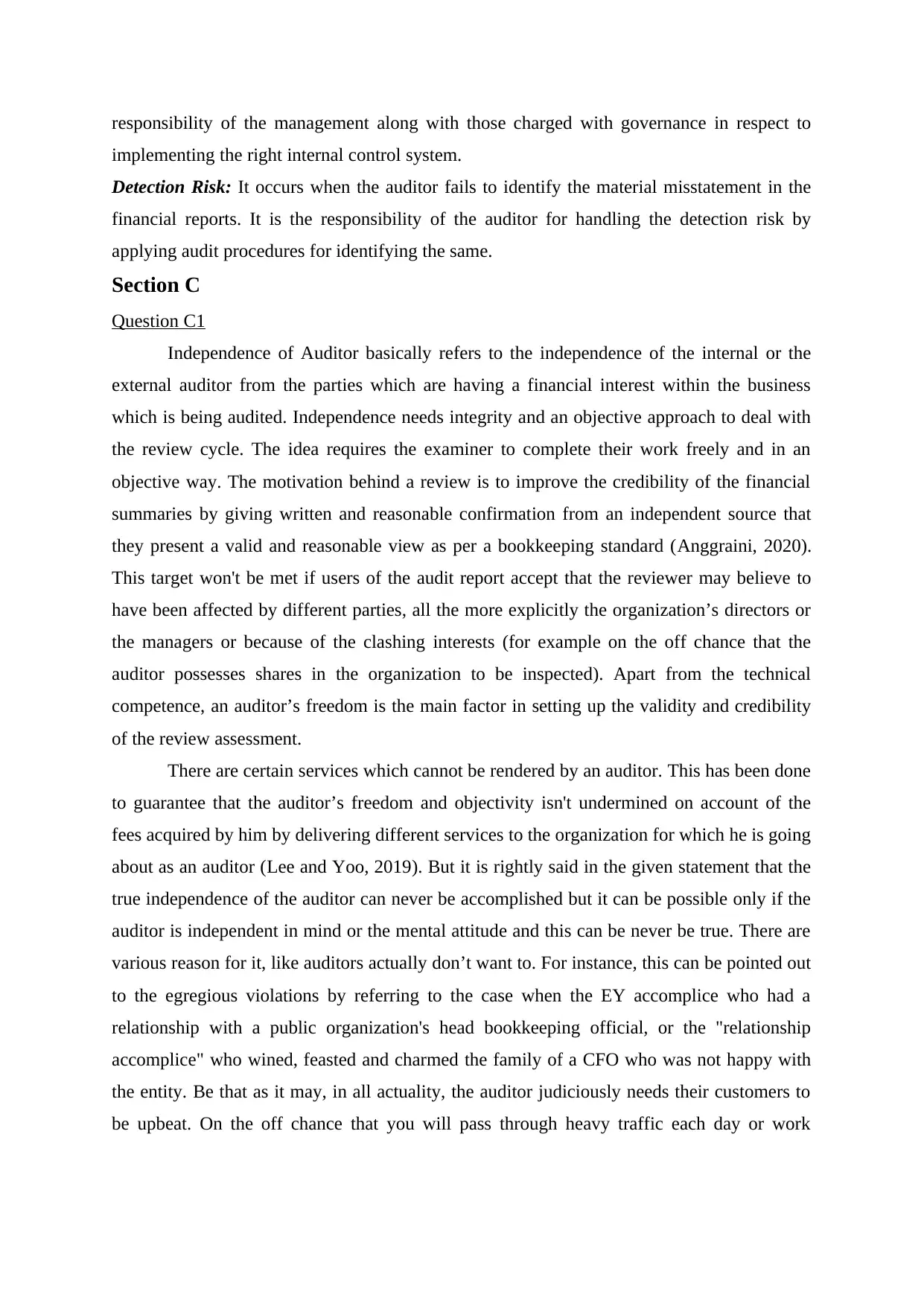
responsibility of the management along with those charged with governance in respect to
implementing the right internal control system.
Detection Risk: It occurs when the auditor fails to identify the material misstatement in the
financial reports. It is the responsibility of the auditor for handling the detection risk by
applying audit procedures for identifying the same.
Section C
Question C1
Independence of Auditor basically refers to the independence of the internal or the
external auditor from the parties which are having a financial interest within the business
which is being audited. Independence needs integrity and an objective approach to deal with
the review cycle. The idea requires the examiner to complete their work freely and in an
objective way. The motivation behind a review is to improve the credibility of the financial
summaries by giving written and reasonable confirmation from an independent source that
they present a valid and reasonable view as per a bookkeeping standard (Anggraini, 2020).
This target won't be met if users of the audit report accept that the reviewer may believe to
have been affected by different parties, all the more explicitly the organization’s directors or
the managers or because of the clashing interests (for example on the off chance that the
auditor possesses shares in the organization to be inspected). Apart from the technical
competence, an auditor’s freedom is the main factor in setting up the validity and credibility
of the review assessment.
There are certain services which cannot be rendered by an auditor. This has been done
to guarantee that the auditor’s freedom and objectivity isn't undermined on account of the
fees acquired by him by delivering different services to the organization for which he is going
about as an auditor (Lee and Yoo, 2019). But it is rightly said in the given statement that the
true independence of the auditor can never be accomplished but it can be possible only if the
auditor is independent in mind or the mental attitude and this can be never be true. There are
various reason for it, like auditors actually don’t want to. For instance, this can be pointed out
to the egregious violations by referring to the case when the EY accomplice who had a
relationship with a public organization's head bookkeeping official, or the "relationship
accomplice" who wined, feasted and charmed the family of a CFO who was not happy with
the entity. Be that as it may, in all actuality, the auditor judiciously needs their customers to
be upbeat. On the off chance that you will pass through heavy traffic each day or work
implementing the right internal control system.
Detection Risk: It occurs when the auditor fails to identify the material misstatement in the
financial reports. It is the responsibility of the auditor for handling the detection risk by
applying audit procedures for identifying the same.
Section C
Question C1
Independence of Auditor basically refers to the independence of the internal or the
external auditor from the parties which are having a financial interest within the business
which is being audited. Independence needs integrity and an objective approach to deal with
the review cycle. The idea requires the examiner to complete their work freely and in an
objective way. The motivation behind a review is to improve the credibility of the financial
summaries by giving written and reasonable confirmation from an independent source that
they present a valid and reasonable view as per a bookkeeping standard (Anggraini, 2020).
This target won't be met if users of the audit report accept that the reviewer may believe to
have been affected by different parties, all the more explicitly the organization’s directors or
the managers or because of the clashing interests (for example on the off chance that the
auditor possesses shares in the organization to be inspected). Apart from the technical
competence, an auditor’s freedom is the main factor in setting up the validity and credibility
of the review assessment.
There are certain services which cannot be rendered by an auditor. This has been done
to guarantee that the auditor’s freedom and objectivity isn't undermined on account of the
fees acquired by him by delivering different services to the organization for which he is going
about as an auditor (Lee and Yoo, 2019). But it is rightly said in the given statement that the
true independence of the auditor can never be accomplished but it can be possible only if the
auditor is independent in mind or the mental attitude and this can be never be true. There are
various reason for it, like auditors actually don’t want to. For instance, this can be pointed out
to the egregious violations by referring to the case when the EY accomplice who had a
relationship with a public organization's head bookkeeping official, or the "relationship
accomplice" who wined, feasted and charmed the family of a CFO who was not happy with
the entity. Be that as it may, in all actuality, the auditor judiciously needs their customers to
be upbeat. On the off chance that you will pass through heavy traffic each day or work
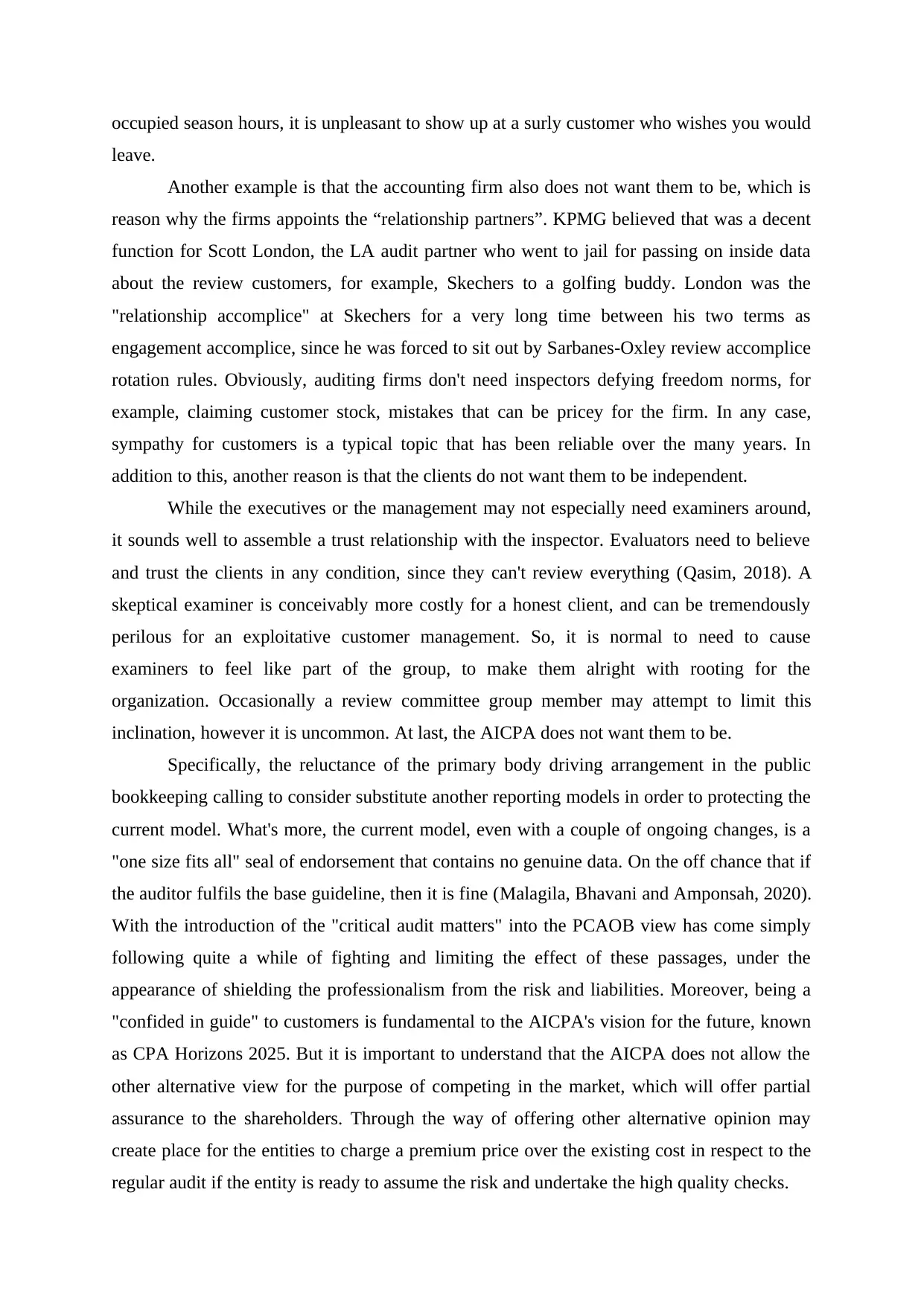
occupied season hours, it is unpleasant to show up at a surly customer who wishes you would
leave.
Another example is that the accounting firm also does not want them to be, which is
reason why the firms appoints the “relationship partners”. KPMG believed that was a decent
function for Scott London, the LA audit partner who went to jail for passing on inside data
about the review customers, for example, Skechers to a golfing buddy. London was the
"relationship accomplice" at Skechers for a very long time between his two terms as
engagement accomplice, since he was forced to sit out by Sarbanes-Oxley review accomplice
rotation rules. Obviously, auditing firms don't need inspectors defying freedom norms, for
example, claiming customer stock, mistakes that can be pricey for the firm. In any case,
sympathy for customers is a typical topic that has been reliable over the many years. In
addition to this, another reason is that the clients do not want them to be independent.
While the executives or the management may not especially need examiners around,
it sounds well to assemble a trust relationship with the inspector. Evaluators need to believe
and trust the clients in any condition, since they can't review everything (Qasim, 2018). A
skeptical examiner is conceivably more costly for a honest client, and can be tremendously
perilous for an exploitative customer management. So, it is normal to need to cause
examiners to feel like part of the group, to make them alright with rooting for the
organization. Occasionally a review committee group member may attempt to limit this
inclination, however it is uncommon. At last, the AICPA does not want them to be.
Specifically, the reluctance of the primary body driving arrangement in the public
bookkeeping calling to consider substitute another reporting models in order to protecting the
current model. What's more, the current model, even with a couple of ongoing changes, is a
"one size fits all" seal of endorsement that contains no genuine data. On the off chance that if
the auditor fulfils the base guideline, then it is fine (Malagila, Bhavani and Amponsah, 2020).
With the introduction of the "critical audit matters" into the PCAOB view has come simply
following quite a while of fighting and limiting the effect of these passages, under the
appearance of shielding the professionalism from the risk and liabilities. Moreover, being a
"confided in guide" to customers is fundamental to the AICPA's vision for the future, known
as CPA Horizons 2025. But it is important to understand that the AICPA does not allow the
other alternative view for the purpose of competing in the market, which will offer partial
assurance to the shareholders. Through the way of offering other alternative opinion may
create place for the entities to charge a premium price over the existing cost in respect to the
regular audit if the entity is ready to assume the risk and undertake the high quality checks.
leave.
Another example is that the accounting firm also does not want them to be, which is
reason why the firms appoints the “relationship partners”. KPMG believed that was a decent
function for Scott London, the LA audit partner who went to jail for passing on inside data
about the review customers, for example, Skechers to a golfing buddy. London was the
"relationship accomplice" at Skechers for a very long time between his two terms as
engagement accomplice, since he was forced to sit out by Sarbanes-Oxley review accomplice
rotation rules. Obviously, auditing firms don't need inspectors defying freedom norms, for
example, claiming customer stock, mistakes that can be pricey for the firm. In any case,
sympathy for customers is a typical topic that has been reliable over the many years. In
addition to this, another reason is that the clients do not want them to be independent.
While the executives or the management may not especially need examiners around,
it sounds well to assemble a trust relationship with the inspector. Evaluators need to believe
and trust the clients in any condition, since they can't review everything (Qasim, 2018). A
skeptical examiner is conceivably more costly for a honest client, and can be tremendously
perilous for an exploitative customer management. So, it is normal to need to cause
examiners to feel like part of the group, to make them alright with rooting for the
organization. Occasionally a review committee group member may attempt to limit this
inclination, however it is uncommon. At last, the AICPA does not want them to be.
Specifically, the reluctance of the primary body driving arrangement in the public
bookkeeping calling to consider substitute another reporting models in order to protecting the
current model. What's more, the current model, even with a couple of ongoing changes, is a
"one size fits all" seal of endorsement that contains no genuine data. On the off chance that if
the auditor fulfils the base guideline, then it is fine (Malagila, Bhavani and Amponsah, 2020).
With the introduction of the "critical audit matters" into the PCAOB view has come simply
following quite a while of fighting and limiting the effect of these passages, under the
appearance of shielding the professionalism from the risk and liabilities. Moreover, being a
"confided in guide" to customers is fundamental to the AICPA's vision for the future, known
as CPA Horizons 2025. But it is important to understand that the AICPA does not allow the
other alternative view for the purpose of competing in the market, which will offer partial
assurance to the shareholders. Through the way of offering other alternative opinion may
create place for the entities to charge a premium price over the existing cost in respect to the
regular audit if the entity is ready to assume the risk and undertake the high quality checks.
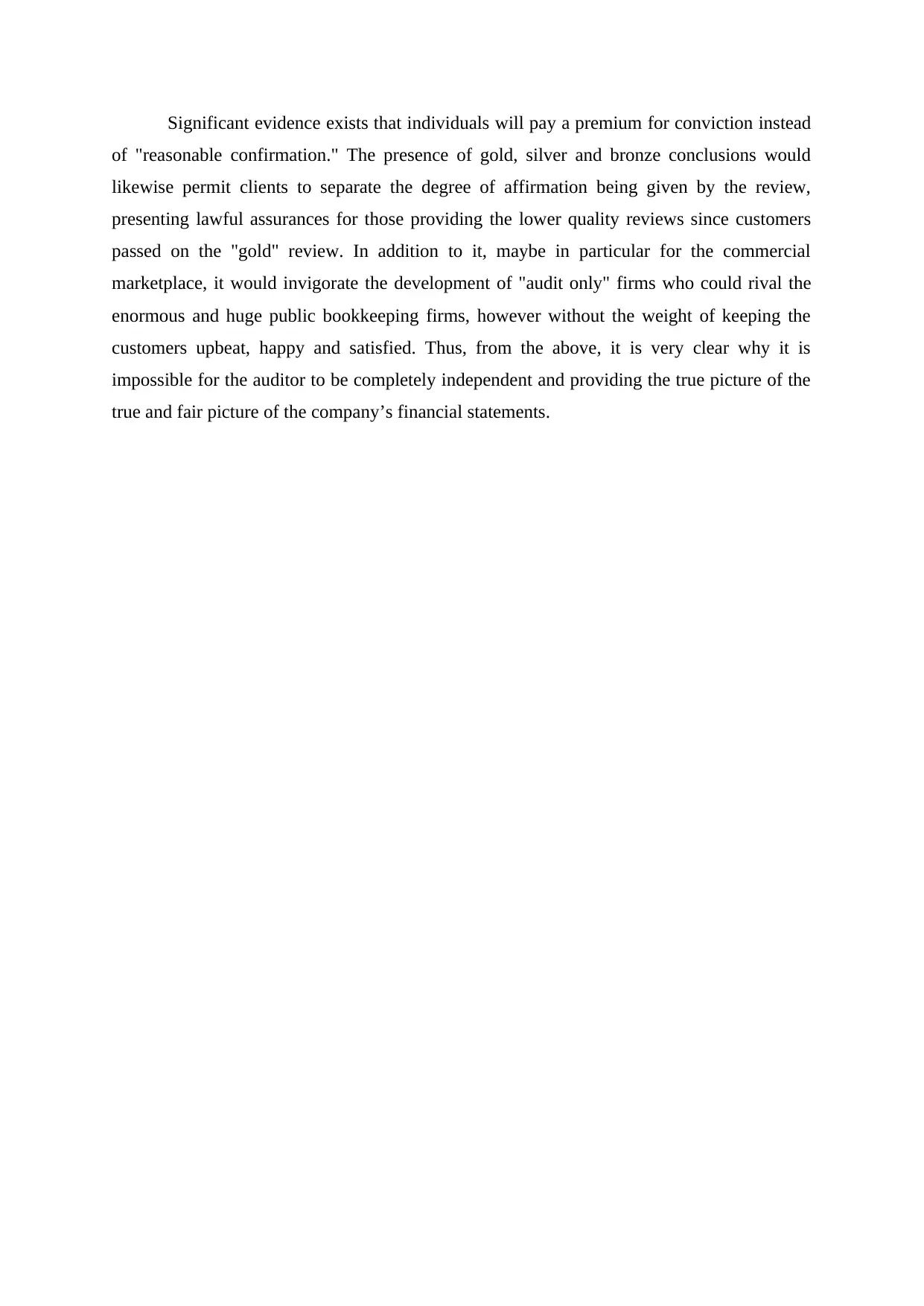
Significant evidence exists that individuals will pay a premium for conviction instead
of "reasonable confirmation." The presence of gold, silver and bronze conclusions would
likewise permit clients to separate the degree of affirmation being given by the review,
presenting lawful assurances for those providing the lower quality reviews since customers
passed on the "gold" review. In addition to it, maybe in particular for the commercial
marketplace, it would invigorate the development of "audit only" firms who could rival the
enormous and huge public bookkeeping firms, however without the weight of keeping the
customers upbeat, happy and satisfied. Thus, from the above, it is very clear why it is
impossible for the auditor to be completely independent and providing the true picture of the
true and fair picture of the company’s financial statements.
of "reasonable confirmation." The presence of gold, silver and bronze conclusions would
likewise permit clients to separate the degree of affirmation being given by the review,
presenting lawful assurances for those providing the lower quality reviews since customers
passed on the "gold" review. In addition to it, maybe in particular for the commercial
marketplace, it would invigorate the development of "audit only" firms who could rival the
enormous and huge public bookkeeping firms, however without the weight of keeping the
customers upbeat, happy and satisfied. Thus, from the above, it is very clear why it is
impossible for the auditor to be completely independent and providing the true picture of the
true and fair picture of the company’s financial statements.
Secure Best Marks with AI Grader
Need help grading? Try our AI Grader for instant feedback on your assignments.
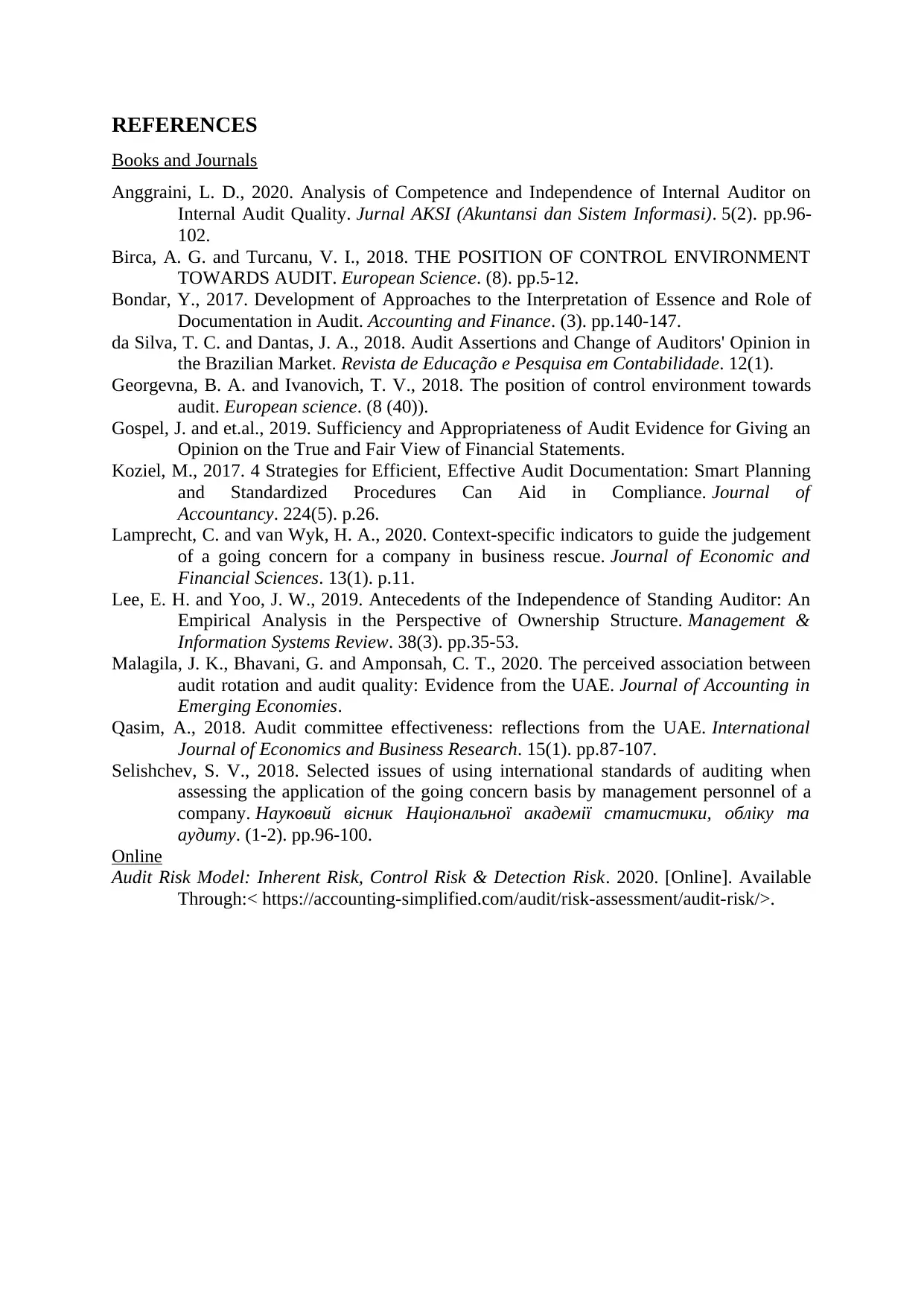
REFERENCES
Books and Journals
Anggraini, L. D., 2020. Analysis of Competence and Independence of Internal Auditor on
Internal Audit Quality. Jurnal AKSI (Akuntansi dan Sistem Informasi). 5(2). pp.96-
102.
Birca, A. G. and Turcanu, V. I., 2018. THE POSITION OF CONTROL ENVIRONMENT
TOWARDS AUDIT. European Science. (8). pp.5-12.
Bondar, Y., 2017. Development of Approaches to the Interpretation of Essence and Role of
Documentation in Audit. Accounting and Finance. (3). pp.140-147.
da Silva, T. C. and Dantas, J. A., 2018. Audit Assertions and Change of Auditors' Opinion in
the Brazilian Market. Revista de Educação e Pesquisa em Contabilidade. 12(1).
Georgevna, B. A. and Ivanovich, T. V., 2018. The position of control environment towards
audit. European science. (8 (40)).
Gospel, J. and et.al., 2019. Sufficiency and Appropriateness of Audit Evidence for Giving an
Opinion on the True and Fair View of Financial Statements.
Koziel, M., 2017. 4 Strategies for Efficient, Effective Audit Documentation: Smart Planning
and Standardized Procedures Can Aid in Compliance. Journal of
Accountancy. 224(5). p.26.
Lamprecht, C. and van Wyk, H. A., 2020. Context-specific indicators to guide the judgement
of a going concern for a company in business rescue. Journal of Economic and
Financial Sciences. 13(1). p.11.
Lee, E. H. and Yoo, J. W., 2019. Antecedents of the Independence of Standing Auditor: An
Empirical Analysis in the Perspective of Ownership Structure. Management &
Information Systems Review. 38(3). pp.35-53.
Malagila, J. K., Bhavani, G. and Amponsah, C. T., 2020. The perceived association between
audit rotation and audit quality: Evidence from the UAE. Journal of Accounting in
Emerging Economies.
Qasim, A., 2018. Audit committee effectiveness: reflections from the UAE. International
Journal of Economics and Business Research. 15(1). pp.87-107.
Selishchev, S. V., 2018. Selected issues of using international standards of auditing when
assessing the application of the going concern basis by management personnel of a
company. Науковий вісник Національної академії статистики, обліку та
аудиту. (1-2). pp.96-100.
Online
Audit Risk Model: Inherent Risk, Control Risk & Detection Risk. 2020. [Online]. Available
Through:< https://accounting-simplified.com/audit/risk-assessment/audit-risk/>.
Books and Journals
Anggraini, L. D., 2020. Analysis of Competence and Independence of Internal Auditor on
Internal Audit Quality. Jurnal AKSI (Akuntansi dan Sistem Informasi). 5(2). pp.96-
102.
Birca, A. G. and Turcanu, V. I., 2018. THE POSITION OF CONTROL ENVIRONMENT
TOWARDS AUDIT. European Science. (8). pp.5-12.
Bondar, Y., 2017. Development of Approaches to the Interpretation of Essence and Role of
Documentation in Audit. Accounting and Finance. (3). pp.140-147.
da Silva, T. C. and Dantas, J. A., 2018. Audit Assertions and Change of Auditors' Opinion in
the Brazilian Market. Revista de Educação e Pesquisa em Contabilidade. 12(1).
Georgevna, B. A. and Ivanovich, T. V., 2018. The position of control environment towards
audit. European science. (8 (40)).
Gospel, J. and et.al., 2019. Sufficiency and Appropriateness of Audit Evidence for Giving an
Opinion on the True and Fair View of Financial Statements.
Koziel, M., 2017. 4 Strategies for Efficient, Effective Audit Documentation: Smart Planning
and Standardized Procedures Can Aid in Compliance. Journal of
Accountancy. 224(5). p.26.
Lamprecht, C. and van Wyk, H. A., 2020. Context-specific indicators to guide the judgement
of a going concern for a company in business rescue. Journal of Economic and
Financial Sciences. 13(1). p.11.
Lee, E. H. and Yoo, J. W., 2019. Antecedents of the Independence of Standing Auditor: An
Empirical Analysis in the Perspective of Ownership Structure. Management &
Information Systems Review. 38(3). pp.35-53.
Malagila, J. K., Bhavani, G. and Amponsah, C. T., 2020. The perceived association between
audit rotation and audit quality: Evidence from the UAE. Journal of Accounting in
Emerging Economies.
Qasim, A., 2018. Audit committee effectiveness: reflections from the UAE. International
Journal of Economics and Business Research. 15(1). pp.87-107.
Selishchev, S. V., 2018. Selected issues of using international standards of auditing when
assessing the application of the going concern basis by management personnel of a
company. Науковий вісник Національної академії статистики, обліку та
аудиту. (1-2). pp.96-100.
Online
Audit Risk Model: Inherent Risk, Control Risk & Detection Risk. 2020. [Online]. Available
Through:< https://accounting-simplified.com/audit/risk-assessment/audit-risk/>.
1 out of 11
Related Documents
Your All-in-One AI-Powered Toolkit for Academic Success.
+13062052269
info@desklib.com
Available 24*7 on WhatsApp / Email
![[object Object]](/_next/static/media/star-bottom.7253800d.svg)
Unlock your academic potential
© 2024 | Zucol Services PVT LTD | All rights reserved.





